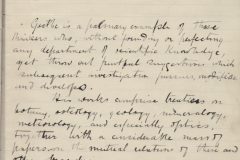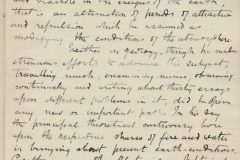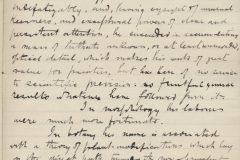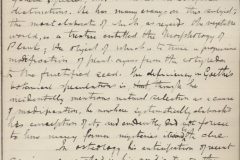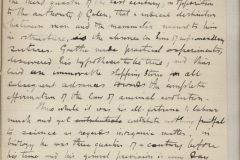Goethe as an Anticipator of Recent Science by Halliwell Thomas
Nov. 22nd 1899
Goethe is a palmary example of those thinkers who, without founding or perfecting any department of scientific knowledge, yet throw out fruitful suggestions which subsequent investigation pursues, modifies and develops.
His works comprise treaties on botany, osteology, geology, mineralogy, meteorology, and especially optics, together with a considerable mass of papers on the mutual relations of these and other branches.
In meteorology he thankfully received the A???-nomenclature of Luke Howard which was a novelty in the beginning of the present century; but Goethe through a painstaking ???? struck out an original track in meteorology. His hypothesis for weather changes was a sort of systole and Diastole in the energies of the earth, that is an alternation of periods of attraction and repulsion which he assumed as modifying the conditions of the atmosphere.
Neither in geology, through he made strenuous efforts to advance this subject, travelling much, examining mines, observing continually and writing about thirty essays upon different problems in it, did he open any new or important path. In his day the principal theoretical controversy bore upon the respective rhuses of fire and water in bringing about present earth conditions. Goethe was neither Plutonist nor Neptunist, bur regarded the attempt to separate the respective shares of these agencies as mostly futile.
The greatest part of Goethe’s endexorum in science was given to optics. In this branch his successes and his failures testify to the signal differences of results obtained in working upon quantitature or upon non-quantitature theories in physics. He was no mathematician, and rejected the aid of arithmetical calculations and algebraic reasoning, and had recourse, therefore, as his only instrument to empirical observation.
His theory was that light and darkness are positive and opposite entities, and that all shades and colours are results of the varying admixtures of light & darkness as conditioned by objects and their relative positions. Founding himself upon fallacies in detail, which he fancied he detected, he rejected Newton’s emission theory, together with the explanations derived from it as to refraction, reflection, and other optical problems.
The undulatory theory of hygiene was revived by Young in Goethe’s time; Goethe notices it in his history of optics; but does not seem to have had sufficient mathematical knowledge to discern its power and range. In order to establish his hypothesis he laboured indefatigably, and, having eyesight of unusual keenness, and exceptional powers of close and persistent attention, he succeeded in accumulating a mass of hithate unknown, or at least unrecorded optical detail, which makes his work of great value for printers, but has been of no service to scientific prevision: no fruitful general results whatever have followed from it.
In morphology his labours were much more fortunate.
In botany his name is associated with a theory of plant-modifications which lay in the direct path formed the now prevalent doctrine of evolution. Early a student of Linnaeus and having all possibility of belief in instantaneous or miraculous creation taken away by the sufficient speculations of the eighteenth century, he was lead to seek for some theory of the origin of living creatures. As regards plants, he became convinced that genera, species, and varieties are artificial distinctions. He has many essays on this subject, the most elaborate of which, as regards the vegetable world, is a treatise entitled the Morphology of Plants; the object of which is to trace a propusine modification of plant-organs from the cotyledon to the fructified seed. The deficiency in Goethe’s botanical speculations is, though he incidentally mentions natural selection as a cause of modification, he nowhere systematically elaborates his conception of it, and evidently did not foresee to him many former mysteries it would be the clue.
In osteology his anticipation of recent science consists in his verification of the existence of the supramaxilla sutures in man. The existence of these sutures had been affirmed by Galen, but of course without any sense of their morphological significance. Goethe, ever in search of unity of type underneath all differences of genera, species and variety, was led to question the statement commonly made in the third quarter of the last century, in opposition to the authority of Galen, that a radical distinction between man and the mammalia nearest to him in structure is the absence in him of supramendlary sutures. Goethe made practical experiments, discovered his hypothesis to be true, and thus laid an immovable stepping stone for all subsequent advances towards the complete affirmation of the law of animal evolution.
Thus while it was his ill-fortune to labour much and yet contribute nothing fruitful to science as regards inorganic matter, in biology he was three quarters of a century before his time and his general prevision is every day being confirmed.
Signed Halliwell Thomas
